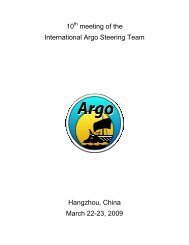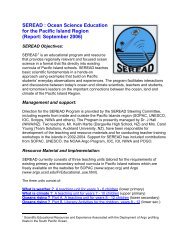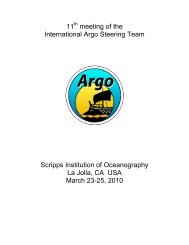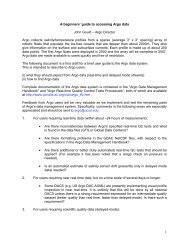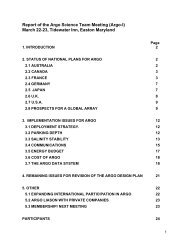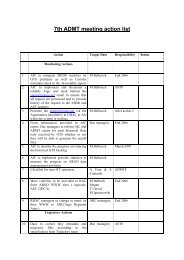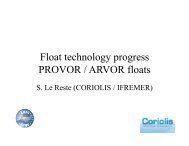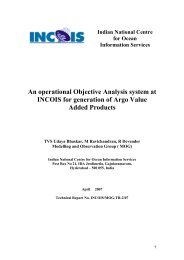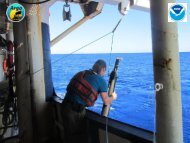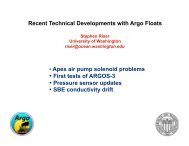AST-12 meeting report posted - Argo
AST-12 meeting report posted - Argo
AST-12 meeting report posted - Argo
You also want an ePaper? Increase the reach of your titles
YUMPU automatically turns print PDFs into web optimized ePapers that Google loves.
afternoon, when surface warm layers were most likely to occur. Comparison of the crosscalibration<br />
measurements showed very small differences between the pumped and nonpumped<br />
measurements (apart from one float where the non-pumped temperatures were<br />
consistently warmer). However, the good agreement was not surprising as in most profiles there<br />
was little or no temperature gradient, so any lag in the non-pumped measurements was<br />
impossible to identify.<br />
For the 2 floats that surfaced during the afternoon, the data showed the existence of nearsurface<br />
temperatures up to 2.5 °C warmer than the uppermost pumped temperature (at<br />
nominally 4 or 5m depth). Although relatively few stratified profiles were observed, the results<br />
show the NST capable Apex floats are able to observe near-surface temperature stratification<br />
that would otherwise remain undetected and so do provide useful additional information.<br />
To better quantify the benefit and accuracy of such near-surface temperature measurements,<br />
more NST capable Apex floats need to be deployed in regions where stratification is most likely<br />
and ‘timed’ to surface during the afternoon when stratification is likely to be strongest. More<br />
such floats are now in the water with 107 NST-capable floats having been deployed in the last 3<br />
years by US, UK, Japan and India. The number is likely to increase over the coming years. It<br />
was planned to continue the analysis, either with a soon to be recruited scientist at the Met<br />
Office or as a summer MSc dissertation project at the University of Reading (with Jon Turton<br />
and Andrea Kaiser-Weiss (GHRSST PO) as supervisors). The <strong>AST</strong> requested that the NSTcapable<br />
float data, from all countries, should be assembled and made available on a publically<br />
accessible website. <strong>AST</strong> also requested that an analysis of all the available data should be<br />
<strong>report</strong>ed to ADMT-<strong>12</strong>, to inform a decision on dissemination of the data via the GDACs.<br />
It was recognised the optimum longer-term approach was to <strong>report</strong> near-surface data from<br />
Iridium floats. Iridium floats typically record at 2 dbar vertical resolution; given the response of<br />
the T sensor (~½ s) it’s possible to sample every second (~0.1 dbar) but with the resolution of<br />
the P sensor (0.1 dbar) it is probably not worth sampling faster than every 2 s (~0.2 dbar<br />
spacing). Hence with Iridium floats it would be possible to meet the GHRSST ‘goal’ of 50 cm<br />
sampling from 5 to 15m depth and the ‘useful’ sampling of 50 cm for less than 5 m depth, but<br />
unlikely to be possible to achieve the 10 cm ‘goal’ accuracy above 5m. However, the accuracy<br />
of <strong>Argo</strong> temperature measurements is likely to be better than standard SST measurements from<br />
drifting buoys and Voluntary Observing Ships and although <strong>Argo</strong> would provide fewer <strong>report</strong>s<br />
they are of high accuracy with vertical information, so would be complimentary to these other<br />
sources.<br />
Action item 28: J. Turton to coordinate gathering unpumped temperature data from<br />
<strong>Argo</strong> PIs and work with GHRSST to place data in a public place and advertise it throughout their<br />
community. J. Turton, Y. Chao.<br />
Action item 29: J. Turton and GHRSST to analyze pumped and unpumped<br />
temperatures. Report back by the time of ADMT. J. Turton, Y. Chao<br />
6.5 <strong>Argo</strong> floats in the ice-zone<br />
S. Wijffels <strong>report</strong>ed on work done by E. Van Wijk and others (see more detailed paper in<br />
appendix) on the prospects for extending <strong>Argo</strong> into the seasonal and fast ice zone.<br />
Seasonal Ice Zone:<br />
There are several options for floats to operate successfully in the seasonal ice zone:<br />
1. Use Iridium/GPS with an ice-avoidance algorithm (AWI or U. Washington)<br />
25



